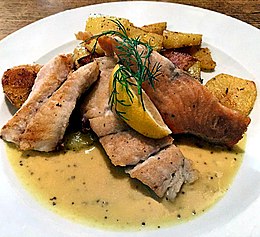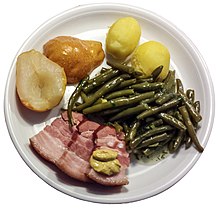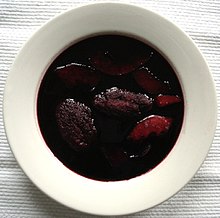Hamburg cuisine
The Hamburg food was far more marked in the 20th century by an extensive fish supply are from the same and the nearby North Sea . Daily deliveries of fresh vegetables came from the Vierlanden ; the fruit was obtained from the old country , until its industrialization Wilhelmsburg was considered a "milk island" for Hamburg. Global trade via the port brought direct access to spices and exotic luxury foods from India and South America, which found their way into middle-class cuisine , as early as the 16th century . The Hamburg cuisine developed on this basis, which has partly lost its own character due to the supra-regional alignment with the North German cuisine .
In terms of gastronomy, Hamburg shows a high level with 13 restaurants that were awarded one or more Michelin stars in 2019 . Among them is Kevin Fehling's restaurant “The Table” in Hafencity , which has three Michelin stars.
Historical
Since the Hanseatic League , Hamburg has been a rich merchant city with the corresponding bourgeoisie. In the large and middle-class homes , the kitchen in the back part were the merchant planks in two different areas separated: there was a "splendid kitchen" in which the tin and copper utensils was presented, and an actual "working kitchen" with a brick oven made of brick and clay. The eating utensils and utensils were kept in a cupboard called Schapp in the hall, jugs and bowls in the bench , a table for serving the food. From the 18th century, kitchens located in the basements of Hamburg merchants' houses are also known.
Many of the dishes handed down as traditional today come from poor households. In the apartments and booths of the lower classes there were no separate kitchens, only a fire hearth in the hall, and since the firewood was expensive, it was not heated for cooking. Warm dishes were accordingly rare and when they were, they were prepared as a stew .
The traditional legend of eating salmon alludes to the class differences in diet. After that, there used to be such an abundance of salmon in Hamburg that it was finally rejected as a poor people's food by the Hamburg servants. The Hamburg council is said to have passed an ordinance that the gentlemen may not give their maids and servants to eat salmon more than twice a week. In fact, salmon were available in abundance and inexpensively well into the 19th century.
Regional cuisine
Fish dishes
The regional cuisine is characterized by a variety of fish dishes, based on the former fish wealth of the Elbe. In addition to various herring dishes such as young herring or Bismarck herring are green pegs , so fresh fish as opposed to pickled or marinated, fried in the pan. By subsequently inserting in ethyl marinade is one of a fried herring Brathering . Smoked eel was already being offered by street vendors in restaurants in the early 19th century. The Finkenwerder plaice is also typical of Hamburg's cuisine. Fish scraps without heads are prepared as pan fish together with fried potatoes , with a mustard sauce . Carp is a traditional Christmas or New Year's Eve dish.
Stews
A stew made from turnips , pork belly and potatoes is known as Hamburger National and is a variant of the turnip mash or turnip stew that is widespread throughout northern Germany . Pears, beans and bacon and Labskaus are further examples of the Hamburg stew cuisine. The Hamburg eel soup , a vegetable stew with soup greens and baked fruit , is known nationwide , and there is a dispute about whether it should traditionally be served with or without eel, whereby the preparation without eel is only assessed as folk etymological ( aal rin in vernacular for everything pure ).
Main courses
Ochsensteert or oxtail pickled in Madeira is a middle-class dish that can be traced back to Hamburg's trade with Portugal and is still very popular today as a soup. Other important dishes are black and sour , heaven, earth and hell, and poultry dishes made from chicken, duck and goose. The house chicks , in particular, are a bygone specialty, they were chicks that were hatched early in the year and actually reared in the Elbmarsch farmers' room and slaughtered young. As in neighboring northern Germany, cabbage dishes are typical dishes in the Hamburg kitchen. In addition to kale , these are, for example, cabbage rolls with savoy cabbage . Under the name Hamburger onion meat two meals are known - on the one hand "roast beef with braised onions and potatoes" as a regional variant of onion flesh as hot prepared dish , on the other hand, also regional variant of the widespread mainly in northern Germany onion meat cold court , a sliced thin onion rings and Marinade.
dessert
Typical desserts of Hamburg cuisine are Rode Grütt ( red grits ) eaten with milk or liquid cream, lilacberry soup , the Big Hans , a dough made from flour, butter, eggs and raisins that is cooked in a closed form in a water bath and eaten with cherry compote, and Brodt pudding with lemon sauce.
Baked
The original bread roll in Hamburg is a round piece , those not used up for breakfast are topped with roast pork as a small snack and poured over with sauce to make the round piece warm . The black bread is a dark, fluffy wholemeal bread. Franzbrötchen is also popular , a tradition from the French era , a high-calorie Danish pastry with plenty of butter, cinnamon and sugar. Franzbrötchen is said to have been the attempt by the Hamburgers to bake croissants .
In the afternoon, with tea or coffee, Copenhagener is served, a Danish pastry filled with red jam or marzipan, which is called Wienerbrød in Denmark . For a real Hamburg apple pie , the apples are fried in a pan and deglazed with white wine before they are further processed.
During the Christmas season there is Klöben , a yeast pastry with raisins and succade that is baked in bread form. Brown cakes are based on a recipe developed in 1782 by the Altona bakery and confectionery Kemm, which was family-owned until 1889. They are baked crispy with beet syrup and gingerbread spices as thin, rectangular biscuits. White cakes, on the other hand, are larded sugar pastries.
Hot rolls were mainly eaten during Lent, it is a yeast pastry with currants , dusted with icing sugar, which can be cut open and filled with whipped cream.
beverages
beer
Beer brewing has been documented in Hamburg since the early 14th century , in 1375 there were 457 breweries in Hamburg, 270 of which were producing for export. The annual production was about 170,000 hectoliters. In the following centuries, the export could be increased with the qualitative improvement in the change from red and dark beer to wheat beer . The recipe with the addition of hops when brewing beer was kept as a secret and its passing on was made a punishable offense. The beer export, together with the opening of trade routes by the Hanseatic League, formed the basis of the wealth of Hamburg, which was known as the “brewery of the Hanseatic League”.
In the 16th century there were around 600 houses with brewing permits in Hamburg, and the beer produced there was exported to Sweden and Russia on cargo ships. From the 17th century onwards, bock beer was also exported via Hamburg. The Einbeckers maintained their own warehouse with transhipment facilities in the Eimbeck house . In the 18th century, both production and exports fell sharply; it was only with the strong population growth in the late 19th century that new breweries emerged in Hamburg and its neighboring towns. In 1890 there were 32 companies.
At the end of the 20th century, after several changes of ownership and company, the last larger breweries were closed, such as the Elbschloss Brewery founded in Nienstedten in 1881 , whose brewing operations were finally discontinued in 1997 and Bavaria-St. Pauli brewery , whose plant was closed in 2003. The Holsten brewery , founded in Altona in 1879, was in existence, but was taken over by the Carlsberg brewery in 2004. In the 1980s, the private breweries Gröningers Braukeller (1982) in the old Gröninger brewery in Neustadt and Johann Albrecht Brewery (1989) on the Adolphsbrücke were established . After the turn of the millennium there were further foundings, so that beer brewing in Hamburg is again given some importance.
spirits
A schnapps that was often drunk in simple restaurants until after the middle of the 20th century is Kümmel or Köm , a colorless grain brandy similar to aquavit . Helbing Kümmel is probably the best-known Hamburg brand. In combination with beer, Kümmel or Korn were mainly taken in harbor bars under the name Lütt un Lütt . Trade with South America brought rum in particular to the port city. From the sailor culture is Grog handed.
Import of wine
The focus was on the import of wines from the Médoc region via Bordeaux , which were stored here in barrels with low temperature fluctuations and a damp and foggy climate until they were matured in the bottle and took on the flavor of Rotspon .
Import of coffee and tea
A large part of German coffee and tea imports are still handled via Hamburg today, where the individual varieties are mixed and, in the case of coffee, also roasted. The different sorts have been valued here since the 17th century and were very popular. The first coffee house in Hamburg is proven to be in 1677.
Web links
- Hamburg Cuisine - Dishes and Recipes ( Memento from March 6, 2010 in the Internet Archive ), on hamburg.de, accessed May 17, 2009
- Regional recipes and dishes from Hamburg
Individual evidence
- ^ Claus Silvester Dörner, Ilse Sibylle Dörner: The Hamburg cookbook. The fine bourgeois cuisine of the Hanseatic city , Husum Druck- und Verlagsgesellschaft, 2009, ISBN 3-88042-651-1 , p. 13
- ↑ Carola Große-Wilde: Gourmet Bible: 18 Michelin stars for Hamburg restaurants. In: welt.de . February 26, 2019, accessed May 18, 2019 .
- ^ Ernst Finder : Hamburg bourgeoisie in the past . Hamburg 1930, p. 253
- ↑ Rita Bake, Birgit Kiupel: Subject and feeling lexicon in alphabetical order from farewell to confectioner . Hamburg 1987, p. 75
- ↑ Otto Benecke: From eating salmon on Wikisource
- ↑ see more specific explanations under eel soup
- ↑ see Hamburg Cookbook of 1798, quoted from Rita Bake, Birgit Kiupel: Sach- und Emotslexikon in alphabetical order from Abschied bis Zuckerbäcker , Hamburg 1987, p. 19
- ↑ Sebastian Husen: Brown cake . In: Franklin Kopitzsch , Daniel Tilgner (Ed.): Hamburg Lexikon. 3rd, updated edition. Ellert & Richter, Hamburg 2005, ISBN 3-8319-0179-1 , p. 83.
- ↑ Jörgen Bracker: The economic importance of beer export . In: Hamburg. From the beginning to the present. Turning marks in a city history , Hamburg 1988, p. 64 f.
- ^ Sebastian Husen: Beer . In: Franklin Kopitzsch, Daniel Tilgner (Ed.): Hamburg Lexikon. 3rd, updated edition. Ellert & Richter, Hamburg 2005, ISBN 3-8319-0179-1 , p. 68.
- ↑ Hamburg-Magazin: Brauhäuser , accessed on May 8, 2015
- ^ Franklin Kopitzsch: Coffee houses . In: Franklin Kopitzsch, Daniel Tilgner (Ed.): Hamburg Lexikon. 3rd, updated edition. Ellert & Richter, Hamburg 2005, ISBN 3-8319-0179-1 , p. 263.




